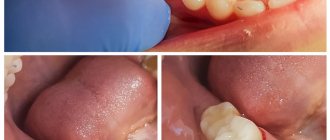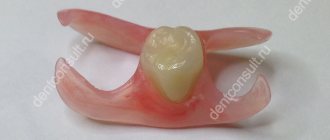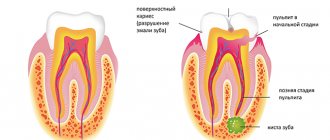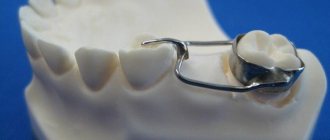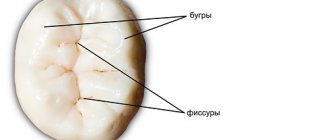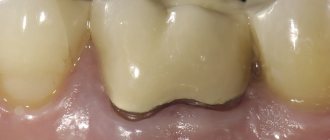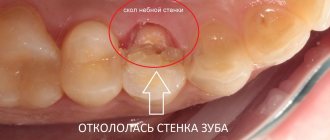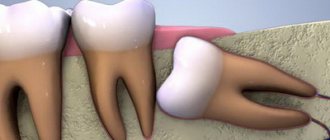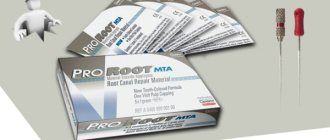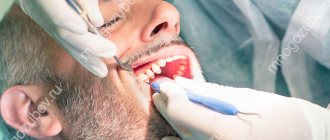- Should I remove the root or not?
- What to do if a tooth is fractured?
Athletes are at risk for broken teeth, however, even without being a boxer or hockey player, everyone has a chance to break a tooth.
A fall on ice, a car accident, an overly “hard” nut or cracker – all this can cause an unpleasant situation when the crown part is broken at the root. What to do in this case, and what measures should be taken before going to the doctor:
- Apply dry cold.
- Suspecting that not only the tooth, but the entire jaw is broken, it is necessary to immobilize it and apply a splint.
- If possible, take a broken tooth with you to the doctor.
After this, you must immediately go to the dentist.
The crown part of the front tooth is broken
If a front tooth is partially fractured, veneers or crowns can be used.
Veneers restore tooth function, protect dentin from external influences, and also the aesthetics of a smile. Treatment is only suitable for slightly damaged teeth. If the dental crown is severely damaged, the dentist will suggest installing a ceramic crown.
Crowns are placed on the remaining part of the tooth after grinding and preparing the surrounding area around the damaged tooth. If a significant part of the tooth has broken off, then to securely fix the crown it will be necessary to make a stump inlay, and in this case the tooth will have to be depulped (remove the nerve and fill the root canal).
The main stages of tooth restoration using a crown:
- Drawing up and agreeing on a treatment plan;
- Next, the doctor grinds the tooth down for a crown;
- Taking a silicone impression. The impression is sent to the dental laboratory. Based on the impression, the technicians reconstruct a plaster model of the teeth, and the technician will model the crown on it;
- When the crown is made, it is tried on and, if there is no discomfort, fixed on the stump.
To close the aesthetic defect, until the permanent crown is made, I install temporary plastic crowns on the patient, which can be made either in the laboratory or in the clinic.
Material for making dental crowns .
Front teeth are a person’s calling card. When smiling, in conversation, every person involuntarily exposes his front teeth. Their beauty and health attract their interlocutor. This is why choosing the type of crown for teeth in the smile area is so important. The main types of permanent dental crowns are metal-ceramics, metal-free ceramics and ceramics with a zirconium dioxide frame. The most preferable material, from an aesthetic point of view, for the manufacture of dental crowns for the front teeth is metal-free ceramics e.max or feldspathic ceramics, also ceramics with a zirconium dioxide frame.
Should I remove the root or not?
The first thing a patient with a broken tooth is asked to do in the clinic is to undergo an x-ray examination. Thanks to him, it will be possible to understand what condition the root is in and whether it is possible to preserve it. You can assume that we are talking about a root fracture based on such signs as bleeding from under the gums, the inability to connect teeth due to severe pain, obvious swelling of the gums or discoloration. If the root is broken, it must be removed.
In the case where the upper part of the tooth is broken, but the root remains intact, restoration can be carried out by installing an anchor or fiberglass pin. It is inserted into the root canal and serves as the basis for the subsequent application of layers of composite material. The advantages of this method include speed of implementation and minimal cost. The disadvantages are insufficient strength (excessive loads are contraindicated for a pinned tooth), and a shorter service life compared to implantation - about 3-5 years.
Restoration method – bridge prosthesis
Dental bridges got their name for their visual resemblance to a bridge - they are a structure of two crowns, between which artificial teeth are located.
Crowns are placed on your own ground teeth. The advantages of bridges are good aesthetics and reliable fixation. Dental bridges are permanent, making them very comfortable. This type of dental prosthetics requires several visits to the doctor. First, impressions are made, from which a temporary prosthesis is made in a denture laboratory or clinic - the patient will not experience discomfort when communicating due to the absence of a front tooth. At the same time, the dental clinic prepares the supporting teeth. They are ground to install a crown to a shape that is optimally suitable for this, and most often (but not always) they are depulped. After the grinding is completed, impressions are taken again, from which dentists make a permanent prosthesis, and after that it is installed on the supporting teeth and fixed with cement.
The main disadvantage of a bridge is the need for depulpation and grinding of healthy supporting teeth. In addition, its installation, which leads to an uneven load on the alveolar bone and its thinning in the area of the missing tooth..
Peculiarities
Doctors distinguish three stages of tooth decay: minor, partial and complete. Based on the amount of remaining living tissue, the dentist chooses the method and material for restoration. In some cases, it is enough to fill a small chip with a composite or partially build it up with appropriate materials to give it a natural color and shape. If the tooth is completely destroyed, the question of making a prosthesis arises. In this case, therapeutic treatment is pointless, and a prosthetist dentist is involved in the process.
Restoration method - one-stage implantation immediately after root removal
Single-stage implantation of a front tooth involves immediately installing an implant into the socket after tooth extraction. For this type of implantation, special dental implants with aggressive threading and a high degree of primary stabilization are used. On the same day, immediately after implantation, a temporary plastic crown is installed. This implantation allows you to solve two problems - removing a broken tooth root and closing a cosmetic defect. In addition, the method allows you to save a little, because... Some manipulations are not performed (for example, the gum former is not installed).
After 3-4 months, when osseointegration of the implant is complete, permanent crowns are installed. Just as in the case of conventional crowns, from an aesthetic point of view, the best solution for the front teeth is the use of ceramic crowns and, accordingly, abutments. It is preferable to install the crown on a zirconium dioxide abutment, then in any type of lighting the crown will not stand out from the general row of teeth. In our opinion, this option for restoring a broken front tooth is the most optimal.
Advantages and disadvantages of each extension method
Extension using pins
The advantages of this method:
- Simple simulation of an artificial organ.
- The pin is a single piece, giving the tooth strength.
- During the procedure, neighboring organs are practically not affected.
Minuses:
- The nerve in the tooth dies and it may darken.
- Secondary caries may occur.
- The walls of the tooth gradually become thinner during use, which can cause chips.
Using crowns
Advantages:
- there is no risk of secondary caries due to the tightness of the structure;
- the remaining tissues are not damaged;
- achieving high strength;
- maximum aesthetic smile.
The downside is the risk of the crown moving away after some time.
Prevention of bite injuries
What can you do to keep your primary and permanent dentition healthy? Let's look at the recommendations of dentists:
- maintaining oral hygiene: daily brushing with a brush and paste will remove the resulting plaque and bacterial background, which will preserve the strength of the enamel,
- eating healthy foods: rich in calcium, vitamins. These are dairy products, fresh vegetables and fruits, lean meat, cereals and legumes,
- giving up bad habits: cigarette smoke and alcohol negatively affect the enamel, making it weaker,
- refusal of too hard foods: seeds, nut shells, candies - these are not things that can be chewed without dangerous consequences,
- accustoming the child to the culture of oral care: this includes not only hygiene and the need to “gnaw” a carrot or apple for the correct formation of a permanent bite. Regularly explain to your child why you should not chew toys and furniture, open lids and cans with your mouth,
- regular dental examinations: adults are recommended to attend preventive examinations 1-2 times a year, and children – 3-4 times a year.
What to do if you find a splinter in your gum
If you find a chipped piece in the gum, you should not look for solutions to how to remove the fragment or even the entire tooth yourself. Firstly, you must not try to pull it out with your hands or try to pick it up with a toothpick or fork. Secondly, you should not eat or drink anything - so as not to accidentally swallow a fragment. You can gently rinse your mouth several times without sudden movements. Thirdly, you need to urgently contact the dentist on duty so that a professional can assess the severity of the situation and remove the fragment without complications.
What to do if you have a figure eight fracture
What to do if a wisdom tooth is broken? It is worth knowing that the roots of the “eights” are often so curved that endodontic manipulations (passing canals with special thin instruments) do not give a high-quality result. Therefore, treatment of “wise men” pulpitis often becomes a problem, and instead of treatment, dentists, for the most part, insist on removal. But if only a small piece of enamel or dentin has broken off without opening the pulp, then classical tooth-preserving treatment is completely justified.
Why do chips and fractures occur?
Why might a tooth break? The reasons here lie in the strong mechanical impact. For example, a kind of rating of provoking factors looks like this:
- biting hard food: bones, nuts, seeds in the skin, a piece of ice or candy,
- bruises and blows to the jaw: as a result of an accident, fall, etc.,
- malocclusion: when the teeth do not fit together correctly, placing abnormally high pressure on certain areas,
- the presence of a long-standing crack in the enamel, which subsequently enlarged, or if cariogenic bacteria penetrated into its depths and led to the formation of a cavity inside the enamel or dentin,
- an old or incorrectly installed filling: in the first case, extensive caries (with the formation of a carious cavity) may also develop under it. And in the second case, an incorrectly selected material or an over-inflated filling can also lead to cracking and breakage,
- perforation of the root with a drill drill: here you can try to carry out restoration - we’ll talk about this later,
- Bruxism: involuntary and strong clenching of the jaws,
- weak mineralization of the enamel: the protective layer becomes fragile due to congenital pathologies, diseases of the thyroid gland and frequent illnesses (ARVI, influenza, etc.),
- wearing a broken or unsuitable denture: some parts can put a lot of pressure on the dentition.
What to do for a patient with a fracture
What can be done if a tooth is broken? The best step here would be to immediately contact the dentist, because only a professional can conduct a high-quality diagnosis and prescribe treatment. For example, the patient himself can visually determine that a piece of his crown has chipped, but a traumatic lesion of the pulp or an internal crack in the root cannot be determined independently.
Along with a visual examination and questioning of the patient, an X-ray diagnostic is performed - this can be a targeted X-ray or a panoramic image, a computed tomography scan of the entire jaw. The dentist should also have an electroodontometer (EDM) device at his disposal - if the pulp is dead, the diagnostic values will exceed 100 μA, and if the pulp is still viable, but damaged, then the readings will vary from 20 to 90 μA. Readings below 20 µA indicate that the pulp bundle has retained its integrity and is functioning physiologically. Accordingly, the treatment method in all these situations will be different.
